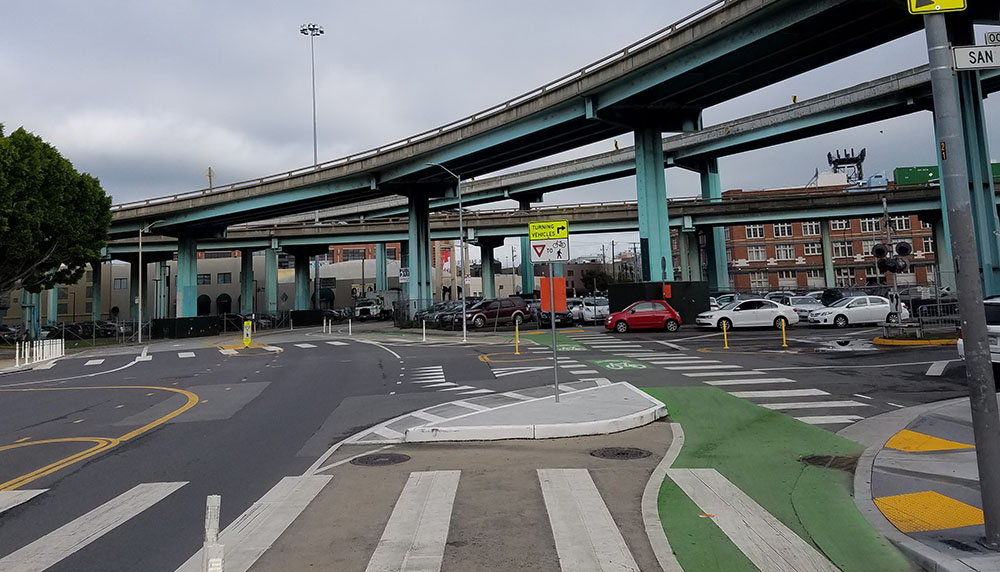Wheel Talk for Wheel People is a monthly advice column written by Christopher White, our adult education program coordinator. Though bikes, biking and getting around SF is our area of expertise, feel free to ask anything! To submit your questions, please click here.
Wheel Talk, when traveling east on Division Street at Ninth Street, neither cars nor bikes in the protected bike lanes have stop signs or signals. Often, cars turn right at this intersection, crossing the bike lane. Who has right of way? Thanks! —Lane-y

Division Street at Ninth Street.
Dear Lane-y: I’ve recently received several questions about protected bike lanes and turning. Protected bike lanes — paths separated from other traffic using soft-hit posts, curbs or even parked cars — are undoubtedly the gold standard for making biking safe and accessible for everyone, at all ages and ability levels. But at intersections, that separation largely falls away; people driving might turn and pass through the bike lane, and people on bikes might need to make a left-hand turn.
To address these issues, one solution is the “protected intersection,” and the intersection you cite is SF’s first example.
At this intersection, when a person in a car intends to turn right from Division, they should heed the signs (posted in both directions) stating that vehicles turning right must yield to people in the crosswalk or bike lane. The corner safety island requires people in cars to make a sharper turn, slowing them down and increasing their time to react to oncoming bikes. But remember: it’s always good to remain alert and exercise caution at intersections, even when you have the right of way. And here, as everywhere, people on bikes should yield to pedestrians!
Wheel Talk, I recognize the importance of test-riding a bike in person. But the prices are often better online. What’s the etiquette for going into a local bike shop to test ride a bike with no intention to buy it there? —Crank Yanker
Dear Crank Yanker: The independent bike shops in our city undoubtedly contribute to safer, more joyous biking for all in SF. They anchor the biking community, educate people and, in my experience, offer excellent and friendly service.
So is it proper etiquette — or even ethical — to test ride a bike at a local bike shop, and then buy it for cheaper online? Usually when you go to a bike shop for a test ride, someone is providing you with service: helping you choose the correct frame size, adjusting the saddle to fit you better, discussing the respective values of caliper vs. disk brakes, etc. The employee’s time is, in fact, the premium for which you might pay by shopping there. Those shops that provide good service are earning that extra cost. You’ll often be repaid with other benefits: some shops offer six months or more of free adjustments if you buy your bike there, for example. If everyone took the path you suggest, all the bike shops in the city would be shuttered in short order, which would be disastrous for you and every other person who bikes: we need the expertise of bicycle mechanics widely dispersed around the city to keep our bikes functioning.
However, if the difference between the online and in-store prices would mean paying your rent and avoiding eviction, you have other options. First, your San Francisco Bicycle Coalition membership (because you are a member, right, Crank Yanker?) gives you access to a discount at many local bike shops on parts and accessories. And if that doesn’t balance the price out, you could talk to the shop manager — preferably before you use their services — and tell them that you’ve found the bike for a better price online; some local shops might consider matching that price in order to earn your business and loyalty.
Wheel Talk, like many people who bike, I sometimes drive as well. When I’m in my car waiting to make a right turn at a red light, I’m unsure where to position myself in relation to a bike lane with a dashed stripe. Should I position my vehicle to wait IN the bike lane or NEXT TO the bike lane? —Avoiding a Turn for the Worst
Dear Avoiding a Turn for the Worst: My little heart sings when I encounter people who understand that, when turning in a car, the proper maneuver is to merge into the dashed portion of the bike lane (after signaling and checking to make sure that no bikes are in the lane) and turn from the curb.
Along with your turn indicator, turning from the curb communicates clearly to people on bikes your intention to go right. They can then take the correct and safest course of action: signaling and merging left into the general traffic lane, out of the bike lane. This do-si-do should be done whether the light at the intersection is red or green. If it’s red, bikes should filter up to the intersection line to the left of your right-turning car, not try to squeeze between your car and the curb. The closer you are to the curb, the less temptation you’ll give to someone on a bike to wriggle through.




